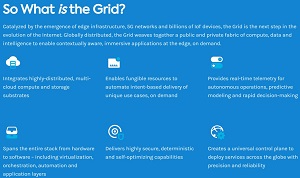News
AWS, VMware Team Up for Distributed Edge AI Networking
Cloud giant AWS has teamed up with virtualization kingpin VMware and others to work on a Proof of Concept (PoC) for "distributed edge AI networking" as part of an Open Grid Alliance (OGA) project.
The OGA was formed in 2021 by VMware and Vapor IO with a mission to define and accelerate what they called the Open Grid, or basically rearchitect the internet for next-gen applications on a global scale. "Globally distributed, the Grid weaves together a public and private fabric of compute, data and intelligence to enable contextually aware, immersive applications at the edge, on demand," the group says.
The need for a rearchitected internet, the OGA's site says, arose because the internet backbone doesn't extend to the edge and was also built for availability and not for performance, thus the project and its PoC emphasize resource-intensive workloads like video-based applications. Along with new applications demanding too much power, a scarcity of edge interconnects forces data to take inefficient routes and furthers the case for an Open Grid.
 [Click on image for larger view.] Open Grid (source: OGA).
[Click on image for larger view.] Open Grid (source: OGA).
Thus the grid:
- Integrates highly-distributed, multi-cloud compute and storage substrates
- Enables fungible resources to automate intent-based delivery of unique use cases, on demand
- Provides real-time telemetry for autonomous operations, predictive modeling and rapid decision-making
- Spans the entire stack from hardware to software -- including virtualization, orchestration, automation and application layers
- Delivers highly secure Delivers highly secure, deterministic and self-optimizing capabilities
- Creates a universal control plane to deploy services across the globe with precision and reliability
The group yesterday (Oct. 9) announced an effort with AWS, VMware and Deutsche Telekom for a proof-of-concept (PoC) described as a globally distributed enterprise network that demonstrates OGA ecosystem collaboration.
The network combines Deutsche Telekom's connectivity services with AWS services and infrastructure, VMware's multi-cloud telco platform, OGA grid nodes, and network function ISVs. It spans multiple campus locations in Prague, Seattle and Bonn, serving to highlight a use case of AI-supported Video-as-a-Service, which leverages real-time resource allocation and distributed AI and centralized analytics.
And, as with all things in IT these days, the OGA played heavily on that AI angle.
"Designed with advanced AI-based applications in mind, this network optimization enables real-time resource allocation for use cases like video analytics, autonomous vehicles, and robotics," the group said.
The Open Grid Manifesto sums up the effort:
Most of what we consume on the internet today originates in a handful of massive data centers located, often, where land and power have been cheap. The applications housed in these data centers rely first on public and private backbones, and then the last mile networks, to carry their logic and data to the fringes, to the edge, where most of us exist and where they can deliver value.
This is the internet we have today. It evolved from the core out, growing naturally like a tree, spawning new limbs as its trunk got thicker and its branches reached farther.
Today, all the innovation is happening at the edge. We are moving from an era of humans talking to machines at the core into an era of machines talking to machines at the edge. We need a next-generation internet, built from the edge in.
VMware, when it helped form the group in 2021, stated the ambitions of the project:
- Begin by virtualizing the data center to build a logical pool of adaptive compute resources spanning multiple geographies.
- Compliment this by virtualizing the networking to make the network invisible to the user.
- Next, virtualize the edge, bringing together disparate providers in a compute grid that provides just the right level of compute, in the right place, at the right time, driven by the application intent.
- With the compute grid in place, take on the more interesting challenge of virtualizing the control to enable universal autonomy with an ‘intelligence grid', our ultimate ambition with the Open Grid.
About the Author
David Ramel is an editor and writer at Converge 360.